C70350 and C70318 Copper Alloys: Composition, Properties, and Applications
Oct 14, 2025In the realm of advanced materials engineering, copper-nickel alloys like C70350 and C70318 are pivotal for high-performance applications requiring a blend of strength, conductivity, and corrosion resistance. As of October 2025, with the global push toward electrification and sustainable manufacturing, these alloys are gaining traction in electronics, aerospace, and renewable energy sectors. The copper alloys market, valued at USD 176.92 billion this year, is projected to reach USD 247.88 billion by 2030 at a CAGR of 5.78%, driven by demand in EVs and AI hardware where reliable interconnects are essential. C70350, a Corson-type alloy, dominates discussions for its superior balance, while C70318, a less standardized variant, offers niche adaptability. This article explores their compositions, properties, applications, and a comparative analysis amid evolving market dynamics.
C70350, also known as CuNi1Co1Si or Wieland-K57, is a wrought copper-nickel alloy with copper comprising the balance (over 96%). It features 1.0-2.0% nickel (Ni) for enhanced strength and corrosion resistance, 0.9-2.0% cobalt (Co) to improve precipitation hardening, 0.5-1.2% silicon (Si) for silicide formation that boosts mechanical integrity, and a trace of magnesium (Mg ≤0.04%) for grain refinement. This formulation adheres to UNS standards and ensures uniform microstructure for optimal performance.
C70318, another copper-nickel wrought alloy, shares a similar base but with refined ratios for specific fabrication needs. While detailed compositions are less publicly standardized, it typically includes copper balance, 1-2% Ni, and minor Si/Co adjustments (around 0.5-1% Si, <1% Co), emphasizing lower impurity levels for cryogenic or high-precision uses. Both alloys are produced via processes like continuous casting and cold rolling, minimizing oxygen content to prevent embrittlement.
Both alloys exhibit excellent electrical conductivity (C70350: 29-34 MS/m or 50% IACS; C70318: comparable at ~45% IACS in tempered states) and thermal conductivity (C70350: 200 W/m·K), making them superior to traditional bronzes. Mechanically, C70350 in TM06 temper offers tensile strength of 840-970 MPa, yield strength of 810-920 MPa, and elongation of ≥4%, with high stress relaxation resistance (retaining 80% strength after 10,000 hours at 150°C). Its density is 8.82 g/cm³, with a coefficient of thermal expansion of 17.6 × 10⁻⁶/K.
C70318 mirrors these but with enhanced ductility for bending (good cold workability) and slightly better machinability, though less suited for welding. Both resist corrosion in natural atmospheres and are insensitive to stress cracking, with C70350 edging out in heat resistance up to 300°C. Compared to beryllium copper, they provide similar strength at a fraction of the cost, ideal for cost-sensitive designs.
C70350 excels in electrical connectors, relays, switches, and heat dissipation plates, where its high strength-to-conductivity ratio supports compact, reliable components in consumer electronics and automotive sensors. In aerospace, it's used for structural parts enduring vibration and thermal cycling, while engineering applications leverage its weldability for gas-shielded arc joints.
C70318 finds niche roles in precision stamped parts and lead frames, particularly in high-frequency RF devices and medical equipment, benefiting from its formability. Shared applications include EV battery interconnects and renewable energy heat exchangers, where corrosion resistance ensures longevity.
| Aspect | C70350 | C70318 |
|---|---|---|
| Key Additives | Ni 1-2%, Co 0.9-2%, Si 0.5-1.2% | Ni 1-2%, Si ~0.5-1%, lower Co |
| Strength (MPa) | 840-970 (tensile) | 750-900 (tensile, more ductile) |
| Conductivity (% IACS) | 50 | 45-50 |
| Best For | High-stress electronics, aerospace | Precision stamping, RF components |
| Cost/Availability | Widely available, cost-effective | Niche, slightly higher fabrication ease |
C70350 outperforms in balanced properties for demanding environments, while C70318 prioritizes workability for intricate designs. Both surpass aluminum bronzes in marine corrosion resistance.
The copper-nickel alloys segment is surging, with the broader nickel alloys market reaching USD 13.22 billion in 2025 and growing at 4.58% CAGR to USD 20.69 billion by 2035, fueled by EV adoption (requiring 83 kg copper per vehicle) and AI data centers. Asia-Pacific holds 55% share, led by China's expansions, but supply disruptions in Chile push prices to USD 4.54/lb. Sustainability drives recycled variants, reducing emissions by 80%, while U.S. CHIPS Act investments spur domestic production. Challenges include volatility from trade tensions, yet innovations like EOS's CuNi30 for additive manufacturing signal growth in 3D-printed components.
For premium copper-nickel solutions, explore Dysen Industrial's offerings at https://www.dysenindustrial.com/copper-and-copper-alloys.
In conclusion, C70350 and C70318 embody the future of resilient materials, bridging performance gaps in a electrified era. Their evolution underscores the need for strategic sourcing amid 2025's market boom.